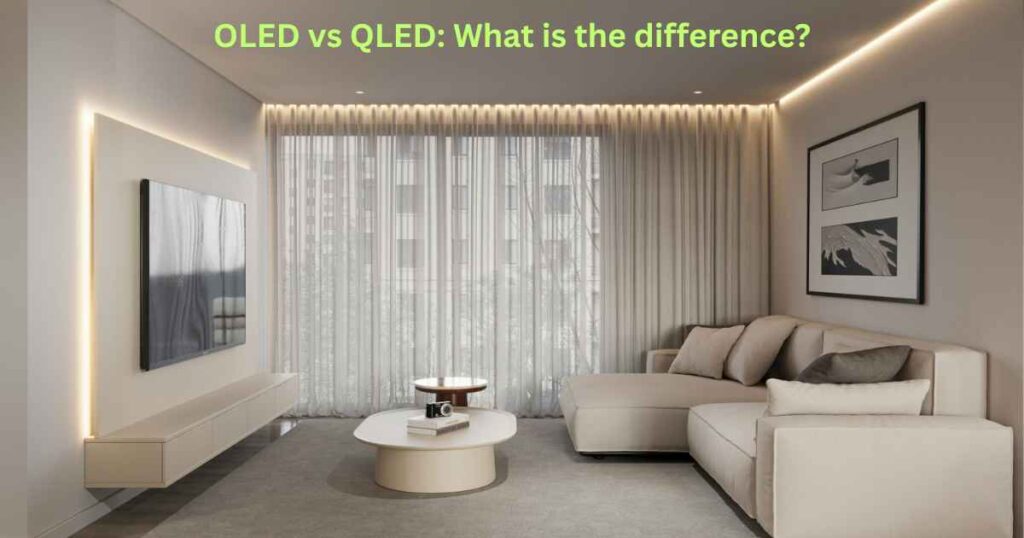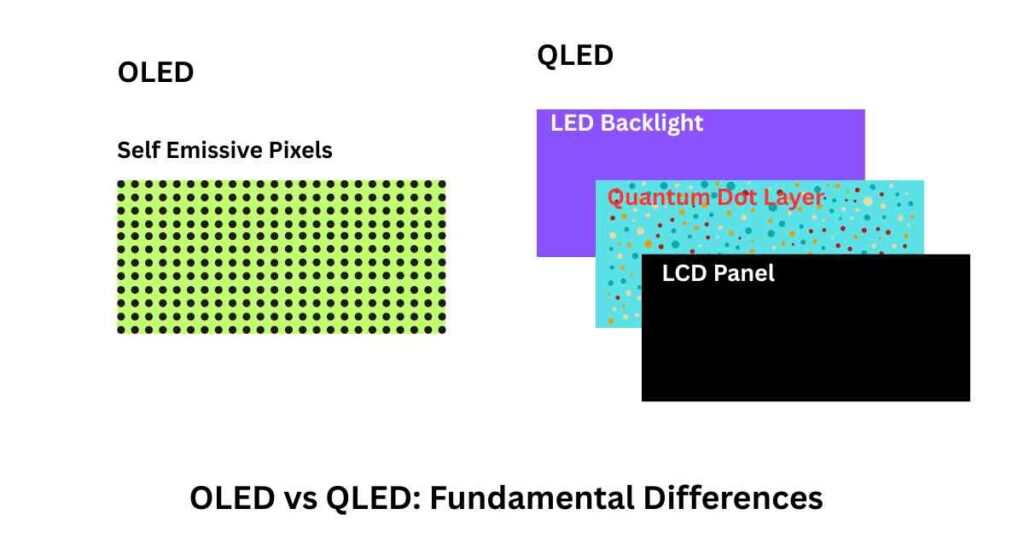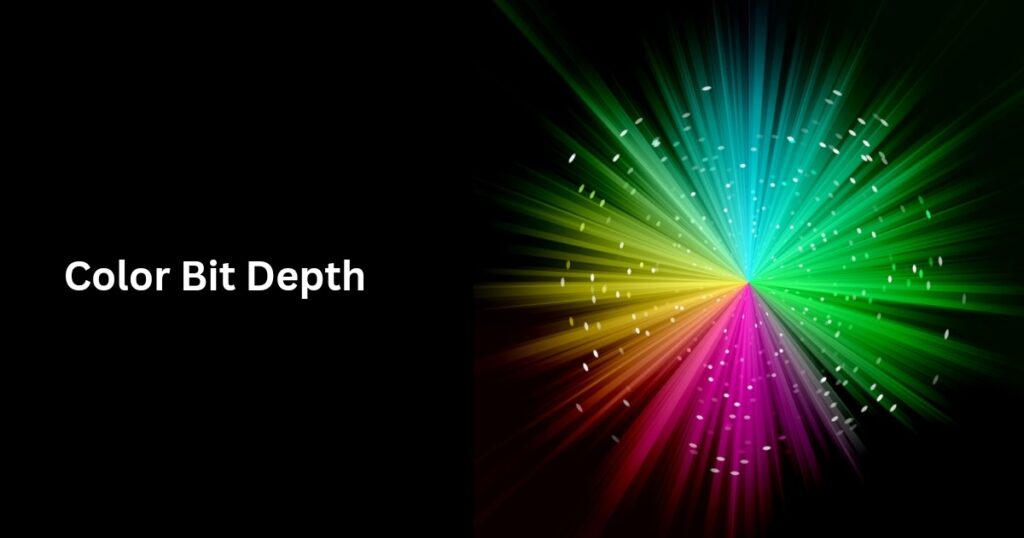OLED vs QLED: What is the difference and which TV to buy?

OLED vs QLED.
The term “LED” stands for Light Emitting Diode.
However, when the letters like “Q” and “O” are added before it to create terms like QLED and OLED, things really get confusing.
Are OLED and QLED similar technologies, or are they fundamentally different?
Let’s explore!
What is an OLED TV?
“OLED” stands for organic – light emitting diode, or organic-LED.
These organic LEDs are extremely small—about the size of a single pixel of the TV.
Now, what is a pixel in a TV?
Well, a pixel (short for picture element) is the smallest unit of a display.
In an OLED TV, each pixel is powered by its own organic LED.
The light source for each individual pixel (organic LED) is embedded directly behind that particular pixel, therefore an OLED TV doesn’t need a separate backlight, unlike a traditional LED or a QLED TV.
Now, while it’s technically possible to place millions of tiny LEDs behind every pixel, (something which is seen in Micro-LED displays), this process is extremely expensive.
The production of these minuscule inorganic LEDs is extremely expensive, which causes prices to rise significantly.
To reduce the cost of self-emissive displays, manufacturers use organic LEDs in screens, leading to the development of what are known as OLED TVs.
This allows each pixel to light up and switch off independently, producing totally dark blacks, thus leading to infinite contrast on OLEDs.
What is the “Q” in QLED?
QLED stands for quantum dot – LED.
Now, you might assume this means that quantum dots are used as light-emitting diodes, similar to how OLEDs work.
But that’s not actually the case.
This is where the marketing around QLED has caused a lot of confusion.
While the “Q” in QLED does stand for quantum dots, these quantum dots are not used as the primary light source in a QLED TV.
Unlike OLED, QLED is not a self-emissive technology.
So, what exactly is QLED?
Let’s break it down next.
What is a QLED TV?
A QLED TV is just a traditional LCD TV that uses an LED backlight and a layer of quantum dots.
In a QLED TV, the backlight is made up of multiple blue LEDs.
Positioned in front of this backlight is a layer of quantum dots.
These quantum dots are nano-sized particles that emit pure colors of single wavelength when illuminated by light.
The blue LED light excites the quantum dots, causing them to produce pure red and green light.
The red and green light produced by the quantum dots combines with the blue light from the LED backlight to create pure white light.
This white light then moves through several LCD layers, where its intensity is controlled by liquid crystals.
After that, it passes through RGB color filters, which separate the white light into red, green, and blue components.
These three colors are then blended in various ways to produce millions of colors on the screen.
So, it’s evident that QLED TVs don’t use quantum dots as the primary light source.
Instead, they rely on a conventional LED backlight, just like standard LED LCD TVs.
The key difference is that QLED TVs use blue LEDs for the backlight, whereas traditional LED TVs use a white backlight.
OLED vs QLED: What are the fundamental differences?

- A QLED TV is nothing but a traditional LED LCD TV only, with an additional layer of quantum dots.
- An OLED TV is not an LCD TV, instead it is a completely different technology.
- A QLED TV relies over an LED backlight as a light source which shines on its pixels to create image.
- An OLED TV has each pixel as an individual light source, therefore it doesn’t need any backlight.
- OLED is self emissive like a micro-LED but a QLED is not, just like its other LCD counterparts.
Now that we’ve covered the basic differences between QLED and OLED technologies, let’s move on to comparing the picture quality they deliver.
OLED vs QLED: Picture Quality
OLED TVs tend to offer consistent picture quality across their various models because they all share the same core technology—self-emissive pixels that produce light independently.
On the other hand, the picture quality of QLED TVs can vary significantly between models.
This variation is due to variation in factors such as the number of local dimming zones, the type of backlighting used, and the method of local dimming.
Let’s break down and examine the individual factors that affect picture quality in OLED and QLED TVs.
OLED vs QLED: Contrast
Contrast is a key element in determining overall picture quality.
The greater is the distinction between the brightest whites and the darkest blacks on a TV, the higher is its contrast ratio.
Since OLED TVs use self-emissive pixels, each pixel can turn off completely when displaying dark areas.
This results in true black levels and an infinite contrast ratio.
This offers exceptional picture quality as deeper blacks allow other colors and fine details to appear more vivid and lifelike.
In QLED TVs, contrast ratio, and therefore picture quality can vary widely.
This variation mostly depends on the type of backlight used.
QLED models that use standard LED backlighting generally have fewer dimming zones, resulting in less precise control over brightness.
As a result, dark areas often appear more grey than black, since the pixels can’t turn off individually like in an OLED.
Additionally, the LED backlight in QLED TVs stays on constantly, even when parts of the screen should be dark.
This causes blooming effect, where bright objects in dark scenes are surrounded by an unwanted halo of light.
QLED TVs that use mini-LED backlighting improve contrast significantly thanks to thousands of tiny LEDs and a much higher number of dimming zones.
While this leads to deeper blacks and significantly reduced blooming, it’s still not on par with the perfect black levels of OLED.
In summary, regardless of the type of backlight used, QLED TVs cannot match OLEDs when it comes to dark room performance or viewing in a dimly-lit area, say a basement.
OLED vs QLED: Brightness
QLED TVs generally achieve much higher brightness levels compared to OLED TVs.
This is because QLEDs rely on powerful LED backlights, which can be turned on very bright.
In contrast, OLED TVs use self-emissive organic pixels without a backlight.
These pixels can only reach a certain brightness level, as pushing them too hard leads to the risk of pixel degradation.
That said, OLED manufacturers have worked hard to boost brightness.
For instance, Samsung’s QD-OLED (quantum dot-OLED) technology combines self-emissive OLED pixels with a quantum dot layer to improve brightness and color performance.
Similarly, LG has introduced MLA (Micro Lens Array) technology, which uses microscopic lenses to focus light more efficiently and increase peak brightness.
These OLED TVs can become brighter than many QLEDs when displaying HDR content.
But, the QLEDs are also not behind when it comes to advancements in display technology.
As we discussed earlier, many QLED TVs now utilize mini-LED backlighting with advanced local dimming, which significantly boosts contrast.
Besides that, this technology also plays a crucial role in brightness performance.
The backlight in these TVs consists of thousands of tiny mini-LEDs that can light up together, delivering exceptionally high peak brightness levels.
This intense brightness is effective at cutting through all the glare and reflections, making the picture clearly visible even in a brightly-lit room.
As a result, QLED TVs with mini-LED backlighting are often the top performers in bright rooms or outdoors.
They can in general, become much brighter than OLEDs in SDR, thus fight the glare more effectively in bright environments.
OLED vs QLED: Color Gamut
OLED TVs feature self-emissive pixels, each of which can glow in a different color.
With millions of these individually controlled pixels, OLED displays are capable of reproducing incredibly accurate shades, resulting in a wide color gamut and excellent color accuracy.
QLED TVs, on the other hand, use blue LEDs in their backlight.
The blue light excites a layer of quantum dots, which then emit highly pure red and green light.
When combined with the blue, these pure primary colors form accurate and vibrant hues across a wide spectrum.
As a result, QLED TVs also achieve a wide color gamut with rich, pure colors.
OLED vs QLED: HDR Performance
HDR stands for high dynamic range, which expands the dynamic range, i.e., enhances contrast and color accuracy of an image.
This allows the image to be rendered with more lifelike brightness levels and more nuanced color shades.
A TV’s HDR performance mainly depends on two factors: contrast ratio and color volume, where color volume refers to the combination of color gamut (range of colors) and peak brightness.
A higher peak brightness allows a TV to display more levels of luminance, enabling colors to appear more vibrant and accurate at various brightness levels.
Both QLED and OLED TVs are capable of producing a wide color gamut.
However, OLED TVs stand out with their infinite contrast ratio, thanks to self-emissive pixels that can turn off completely to deliver true blacks.
This means that bright highlights can appear with striking clarity against perfectly dark backgrounds.
As a result, OLED TVs offer outstanding HDR performance.
In fact, they are the best performers in dark viewing environments.
For viewing in a bright room, a high peak brightness is essential to combat glare and reflections.
Traditional OLED TVs, particularly WOLEDs (White-OLEDs), often struggle with their limited brightness.
However, newer improvements in OLED technology like QD-OLED and MLA-based OLED panels achieve significantly higher peak brightness levels than the traditional OLEDs.
These OLED displays with high peak brightness combined with a wide color gamut, offer a high color volume.
As a result, they render bright highlights with vibrant colors.
When it comes to QLED TVs, they generally offer higher brightness than OLEDs.
However, that isn’t always the case.
Many budget QLED models with standard LED backlighting fall short in HDR performance due to average brightness and contrast.
But if we talk about QLED TVs which use mini-LED backlights, the picture turns out to be different altogether.
These TVs utilize numerous mini-LEDs, which can collectively produce very high brightness levels.
Thanks to a large number of dimming zones, they also offer great contrast.
As a result, with both, a high peak brightness and an impressive contrast, these TVs deliver outstanding HDR performance in bright rooms.
The color volume is excellent, and images are presented with vivid highlights and eye-popping colors.
That said, OLEDs with enhanced brightness, and QLEDs with enhanced contrast, both offer excellent HDR performances which are quite comparable.
OLED vs QLED: Viewing Angles
OLED TVs use self-emissive pixels that can independently turn on or off wherever needed on the screen.
This allows them to achieve very wide viewing angles.
The picture quality remains consistent regardless of where you sit in front of the TV.
On the other hand, QLED TVs mostly use VA panels to achieve high contrast and thus better overall picture quality.
However, this comes at the cost of narrow viewing angles.
The image quality begins to degrade as you move away out of a particular zone in front of the center of the screen.
While the best QLED TVs with advanced local dimming technologies do improve viewing angles to some extent, they still fall much short compared to OLEDs.
OLED vs QLED: Response Time
An OLED TV doesn’t use a backlight as a light source.
Instead, it has organic LEDs embedded directly into the display, allowing each pixel to emit its own light.
This results in virtually no delay between receiving the image signal and displaying it on the screen.
In contrast, a QLED TV still relies on an LED backlight.
The light from the backlight travels through multiple LCD layers before reaching the screen, introducing some delay.
As a result, QLED TVs typically have response times around 4–5 milliseconds or more, whereas OLEDs can respond in as little as 0.1 milliseconds.
Thanks to this ultra-fast response, OLED TVs are ideal for high-paced, competitive gaming where even a fraction of a millisecond can make a difference.
The gaming experience on an OLED is smooth and seamless, with virtually no motion blur or screen tearing.
Resolution, Style, Cost and Size Options
Both QLED and OLED TVs are available in 4K and 8K resolutions, giving you the option to choose from the highest resolutions currently available.
OLED TVs use organic LEDs embedded directly into the panel, which means they don’t require a separate backlight.
In contrast, QLED TVs use an LED backlight along with multiple LCD layers.
As a result, OLED TVs are significantly slimmer than QLEDs—so much so that when viewed from the side, they may appear as thin as a line!
While modern QLED TVs are also quite sleek, they still can’t match the ultra-slim profile of an OLED TV.
Manufacturing a self-emissive display like an OLED is more complex and expensive than producing a QLED, which is based on traditional LCD tech.
As a result, an OLED TV is generally priced higher than a QLED offering somewhat comparable performance.
Since QLED displays are easier and more cost-effective to manufacture, they are available in a wider range of sizes.
For instance, you can find a QLED TV as small as 32 inches and as big as 100 inches or even bigger.
In contrast, OLEDs, while available in a good variety of sizes, currently range from 42 inches to 97 inches.
Therefore, if you’re looking for more size options, QLEDs offer greater flexibility.
That said, OLEDs still cover the most preferred screen sizes for premium viewing experience.
OLED vs QLED: Lifespan
OLED TVs use organic LEDs as individual pixels, which are susceptible to degradation over time, especially if they’re driven too hard to achieve very high brightness levels.
Another concern with OLEDs is the risk of burn-in, which can occur when static elements (such as a news channel logo) remain on the screen for extended periods.
Over time, the pixels in those areas can burn-in, leading to a permanent shadow or ghost image of the static element even after the content has changed.
If this shadow disappears after a while, the issue is referred to as image retention.
However, if it remains permanently on the screen, it is called burn-in.
To prevent this, manufacturers have introduced various features like pixel shifting, logo dimming, and screen refresh functions to minimize the risk.
As a result, for users who watch varied content, burn-in is rare.
With proper usage and awareness, an informed customer is unlikely to encounter issues with burn-in on a modern OLED TV.
In contrast, QLED TVs incorporate inorganic LEDs combined with quantum dots.
Since neither of these components deteriorates over time, QLED TVs are immune to pixel degradation and burn-in.
Therefore, in general, QLED TVs tend to have a longer lifespan compared to OLEDs.
What’s better, OLED or QLED?
When we talk about overall picture quality, OLED clearly has the upper hand compared to QLED.
If you prefer to watch your TV in a dark room, OLED is a much better choice thanks to its perfect black levels and mind blowing contrast.
On the other hand, if your viewing space is bright, a QLED TV with mini-LED backlighting is more effective at handling glare and displaying bright highlights.
For those seeking a versatile all-rounder TV, which is ideal for both dark and bright rooms, gaming, HDR, and more—a QD-OLED TV offers the best of both worlds.
It delivers infinite contrast, bright highlights, fast response and superb HDR performance in one package.
While burn-in is a possible risk with OLEDs, modern prevention features have greatly reduced its chances of happening.
Considering the rate at which TV technology is evolving, many people tend to upgrade their TV within 3–4 years anyway, as newer models are likely to offer better features at lower prices.
What’s next for QLED and OLED TVs?
Micro-LED technology is emerging as a game-changer, aiming to surpass both QLED and OLED displays by addressing their key limitations.
These TVs use individual inorganic micro-LEDs for each pixel, allowing for precise control of light and delivering unmatched contrast levels.
With peak brightness levels reaching even up to 10,000 nits in some of the models, micro-LED displays are currently the brightest on the market.
Combined with a wide color gamut and the highest possible contrast, they offer exceptional HDR performance.
Unlike QLEDs, micro-LED TVs don’t have any blooming, and unlike OLEDs, they don’t suffer from burn-in, thanks to their self-emissive inorganic pixels.
In short, they combine the best of both technologies.
However, MicroLED TVs are currently super expensive and available only in huge sizes.
For instance, the Samsung The Wall All-in-One micro-LED TV is available in a 146-inch size, priced at $219,999.
But, as the technology continues to develop and scale, we can expect their prices to drop significantly and more mainstream sizes to enter the market.
OLED vs QLED: FAQs
Here are some frequently asked questions comparing QLED and OLED TVs.
Which TV is better for daytime viewing, OLED or QLED?
A QLED TV with a mini-LED backlight handles glare and reflections more effectively, making it the better option for bright daytime viewing in a well-lit room.
Which TV is better for viewing at night, OLED or QLED?
An OLED TV, offering exceptional contrast and true blacks, is best for viewing at night in a dark or dimly-lit room.
Which TV handles glare better, OLED or QLED?
QLED TVs typically get brighter than OLEDs in SDR, making them more effective at fighting glare.
Which TV is better for playing on a PS5 or PS5 Pro, OLED or QLED?
An OLED TV is often the better choice for gaming, thanks to its low response time, which helps prevent tearing in fast-paced games.


